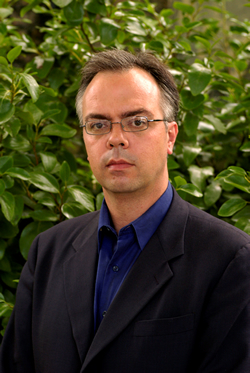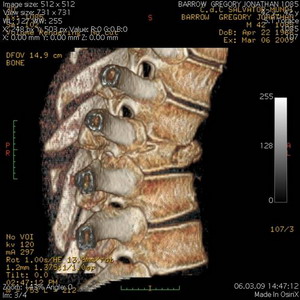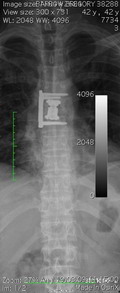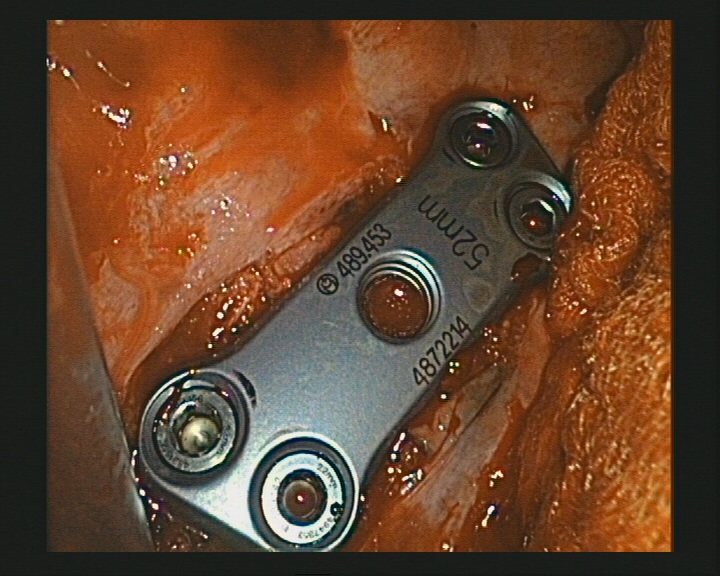
Patientenbericht
Succesful treatment of comminuted thoracic spine fracture in Lindberg-Klinik Winterthur
A report by Greg Barrow
24/02/09 – This was the fifth day of my holiday with my family on the Caribbean island of Barbados. We had driven to a beach on the south of the island called Enterprise beach, just outside the town of Oystins. Enterprise beach is well known for its high waves, but it is also a good place to bring young children as there is a sheltered beach just around the corner which has low waves.
I spent much of the day playing with my young children, but in the afternoon, I decided to rent a “boogie board” — a short surfboard that you can lie on and surf the bigger waves. After renting the board, I entered the sea on Enterprise Beach, where the big waves were coming in and spend an exciting half an hour catching waves and riding them into the shore.
I was just deciding to leave the sea and return to my family when I spotted a big wave growing out to sea. At the time, I was floating in about 2 metres of water. I estimate that the height of the wave by the time it reached me was 1.5 to 2 metres. I started swimming on the board, and the wave sucked me up to its peak, just as it was about to break and collapse in on itself.
Normally, on a boogie board, you can expect a short sensation of falling, before hitting the water and shooting back towards the shore at high speed. This time, I just kept on falling until the right hand side of my head struck the sandy bottom with force. I sensed a flash in my head and struggled to stay conscious as the rest of the wave collapsed on top of me and spat me out towards the shore.
I struggled to gasp for air and was washed around in the sea until another wave washed me further in to shore. At this point, I felt I could not fill my lungs with air, and I was unable to shout for help. Fortunately, a man spotted me and dragged me to safety. A life guard arrived shortly afterwards and tried to ascertain the extent of my injuries.
The most visible injury was on the side of my face and head that was grazed and bleeding from the impact with the sea bed. I was also struggling to breathe and my back was in pain. As a precaution, the lifeguard made my lie on my back on a spinal board and immediately called an ambulance. Another bystander went to call my wife and two children and all of them accompanied me to hospital in Bridgetown.
By the time I reached the hospital in Bridgetown, I was in extreme pain and could only lie with some difficulty on my side. Over the course of the next 6-7 hours, the doctors x-rayed my neck, my ribs and my spine. They concluded that nothing was fractured or broken and that I was suffering from severe soft tissue damage.
That evening, despite the immense pain, I walked out of the hospital and was driven back to our holiday cottage by my wife. On the way back, we picked up a prescription of painkillers (pethidine) and muscle relaxant, which I used for the rest of the holiday.
Despite the pain killers and muscle relaxant, I was in grave discomfort for the rest of my time in Barbados, and only managed to sleep when my body was completely exhausted.
01/03/09 — On this day, I started my journey home from Barbados. That morning, we drove the one hour journey from our cottage to the main airport in Barbados. The first leg of our journey home was an hour long flight in a small propeller plane from the island of Barbados to the island of St Lucia. When we arrived in St Lucia, a taxi driver met us and drove us to a beach where we would spend the day before catching an overnight flight from St Lucia to London’s Gatwick airport.
While sitting on the beach in St Lucia I decided to email my employer’s doctor in Rome (where I live) and explain that I had been injured, and ask his advice on whether I should seek a second opinion. He said that with a spinal injury, it would be prudent to seek further advice and he put me in touch with the Alphamed clinic in Rome, setting up an appointment for Tuesday 3 March.
Later that day, I caught the overnight flight (8 and a half hours) from St Lucia to Gatwick.
02/03/09 — We arrived in Gatwick at about 5:30 am and rushed to catch a 7:00 am flight from Gatwick to Rome. I was still in a lot of pain and spent much of the flight standing upright. When we arrived in Rome, we gathered our luggage and I drove the family back to our apartment in the centre of the city.
03/03/09 — I went to an appointment at the Alphamed clinic with Dr Schaffer who carried out an examination of my back and on seeing my reaction to pressure in certain areas of the spine, he recommended that I should have an MRI scan as soon as possible. The earliest opportunity for the MRI scan was Thursday 5 March.
05/03/09 — At 1600 on Thursday 5 March I went to have an MRI scan and found myself in severe discomfort as I tried to lay still for the twenty minutes that the scan took. When the scan finished, the doctor on site identified that I had crushed the T6 vertebra in my back, but he was not too concerned and said it would heal with bed rest.
06/03/09 — At 11:00 I went for a follow up appointment with Dr Schaffer at Alphamed, and when he saw the scans he immediately called Dr Froehlich to examine them with him. Both doctors were extremely concerned and said that the crushed vertebra was unstable. They also identified fractures in three ribs, two of which were fractured in several places, a fracture in my scapula, and my clavicle, and bruises on my lung. They advised that I should go immediately to hospital where I should lie still on my back until they could decide the best course of treatment. I then travelled by taxi to the Salvator Mundi hospital in Rome where I was admitted, and where I stayed until 16 March. During my stay in Salvator Mundi, I was fitted with a chest brace that allowed me to get out of bed to visit the bathroom, and to undertake mild forms of exercise, including regular physiotherapy.
16/03/09 — I left the Salvator Mundi hospital and travelled on a stretcher in an ambulance to the main airport in Rome. From the airport, I was flown to Zurich, and then transferred by ambulance to the Lindberg Klinik in Winterthur. On arrival at the Lindberg Klinik, I was met for the first time by my surgeon, Professor Rischke, who took the time to reassure me about the operation and talk me through the procedure. Later that afternoon, I met with the anaesthetist who would assist during the operation, and advised on how I should prepare mysefl. Both meetings immediately put me at ease. Later that evening, nurses gave me a sleeping pill to help me to rest ahead of the operation and calm any anxiety that I had.
17/03/09 — I woke early in the morning of my operation, and met again with Professor Rischke and the anaesthetist. By 9 am, I was wheeled into the room next to the operating theatre and given the drugs that would anaesthatise me through the operation. Professor Rischke explained that during the procedure, my right lung would be deflated, and the first step would be to remove the fragments of my vertebra that had been crushed and were pressing on my spinal column. Once the space had been cleared, a titanium bridge would be maneuvred through my rib cage and positioned in the space where the vertebra had once been. At this point, the bridge would be expanded to fit tightly between the two strong vertebra, above and below the one that had been crushed in my accident. The final step was to screw a titanium plate around the bridge so that it was firmly secured in place.
By the time I came around from the operation, the sun had set and it was dark outside. A nurse told me that it was seven o’ clock in the evening, and she assured me that the operation had been successful. My first instinct was to wiggle my feet and try to see if I still had a sensation in my toes. Because of the risk of paralysis after the accident, and the possibility of complications during the operation procedure, I had been nervous about losing feeling in my legs. The good news was that the feeling was there. The next thing I remember was my wife coming to see me. She tells me that I was extremely grumpy and asked her why it had taken her so long to arrive. After my wife, I saw my two young children and my mother who had travelled from London to Winterthur to be around during the operation and my recovery.
18/03/09 — I slept the night comfortably and in the morning I was transferred out of the intensive care unit and back into my hospital room at the Winterthur Klinik. During the day, Professor Rischke visited and encouraged me to try standing up for the first time since my operation. I was extremely nervous about testing my new back, but he assured me that everything was secure, and with a little assistance, I was able to stand on my two feet without the need of a brace for my back.
Over the following days, the nurses and physiotherapists at the Lindberg Klinik were on hand to provide all the care and assistance that I needed, providing extra painkillers and sleeping pills when necessary, and instructing me on the exercises that would help to get my muscles working and build up my strength after the operation. Professor Rischke remained in Winterthur, and cared for me attentively, visiting twice a day, and adjusting my medication when required.
23/03/09 — A week after my operation, and after examining the latest x-rays of my back, Professor Rischke approved my release from the Winterthur Klinik, and I made arrangements to return to Rome the very next day.
26/04/09 — After a month at home resting and recuperating, I have increased mobility and the pain has lessened. I am still on a regular dose of pain killers, but I am trying to decrease the dosage in the coming weeks. My spine appears to be healing well, and the greatest pain is from the fractured ribs and fractured shoulder blade. Although I can move around freely, I have very little stamina and I often find that I have to sleep after a small amount of activity.



